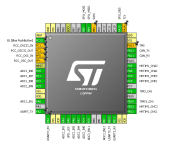lizardmech said:
Most of that is not really the case anymore. Coreless axial flux motors operate at high ERPM, require high PWM speeds and reach 98% efficiency. There's many other motor topology with similar functions like this https://hobbyking.com/en_us/turnigy-typhoon-ferrous-loss-free-helicopter-motor-800kv-600-50-size-heli.html
It is true, coreless motors have near 0 hysteresis loss because of the air "core", however, eddy current losses at high powers are huge because of the high commutation speed, unless wound with litz wire, which is overall less efficient because insulation between strands reduces packing density of copper.
Motors that have have rotating housings, similar to the turnigy you have linked do have near 0 inductive/eddy current loss to the housing, however they still have quite high losses in the laminations.
lizardmech said:
They main issue is the lack of controllers able to handle their requirements. Coreless axial motors are very interesting as they can be printed on PCBs or made DIY very easily. Capacitors are a huge issue on low inductance motors, you need many right next to the fets to suppress voltage ripple. Simulations on capacitor effects on VESC designs often resulted in capacitors producing more heat than the conductive losses in the mosfets. Although you still need an electrolytic near the cable, high switching speeds combined with low ESR ceramic caps gives a huge advantage in power density and efficiency.
All this is about coreless motors is true, but completely non-applicable in this area of operation because of power handling limits.
Ceramic caps are not the solution though because their capacitance vs volume is so tiny, that even though they have very low ESR and ESL, the energy in the voltage ripple is low enough impedance that the capacitance isn't sufficient, and even more so, to get the required capacitance at a decent operating voltage, you are looking at VERY VERY expensive capacitors, that is why in the industry we use film capacitors, for their high voltage, high capacitance (relative to ceramic) and low ESR/ESL (relative to electrolytic). However, while film capacitors are excellent, they are very expensive and not as capacitance dense as electrolytic, so we pair them with electrolytics for the best of both worlds, only using a minimal amount of ceramics.
lizardmech said:
GaN fet price and resistance is rapidly falling while silicon remains much the same. For example https://www.digikey.com/product-detail/en/epc/EPC2033/917-1131-1-ND/5431627
Yes, it is true that price and resistance of GaN FET is falling, it does not mean they are valid design choices yet - or for at least 10 years if progress continues at its current rate.
The example you linked may have a much lower resistance (still much higher than silicon fets in the price range) than most GaN FETs but its packaging makes it very difficult to heatsink, leading to its far lower current rating that other comparable resistance fets, and unsuitable for vibration prone environments, like that of an electric vehicle.
Additionally, GaN devices are far more fragile than silicon devices, incredibly sensitive to over voltage, on both the gate and the drain/source terminals, leading to much more expensive drive and snubbing circuitry.


